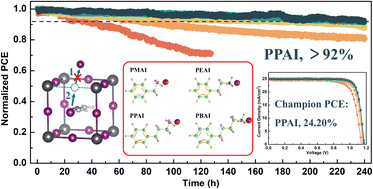Organic iodides in efficient and stable perovskite solar cells: strong surface passivation and interaction†
Abstract
Surface passivation with organic iodides has become a necessary strategy for realizing high-performance perovskite solar cells (PSCs). However, stability degradation of PSCs is always triggered by the migration of iodine interstitial (Ii) defects on the perovskite surface after such treatment. Here, we found that even if the surface treatment is not annealed, it induces the formation of Ii and leads to the subsequent migration behavior. We emphasized the importance of cation selection for organic iodides, and revealed that a strong interaction between cations and perovskite surfaces can suppress the Ii migration through increasing the migration energy barrier. Detailed investigation of four classical phenylalkylammonium iodides demonstrates that the alkyl chain length of cations has an effect on the suppression of Ii migration. Owing to effective defect passivation on the perovskite surface and successful Ii migration inhibition, the phenylpropylammonium iodide-treated PSCs achieve enhanced efficiency and stability simultaneously, obtaining a champion efficiency of 24.20% and retaining about 92% of their initial efficiency after 240 h of continuous illumination during operational stability testing.



 Please wait while we load your content...
Please wait while we load your content...